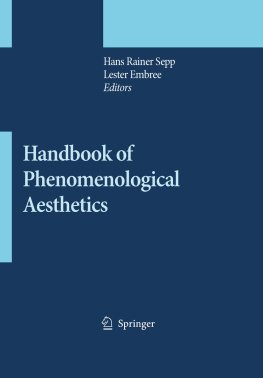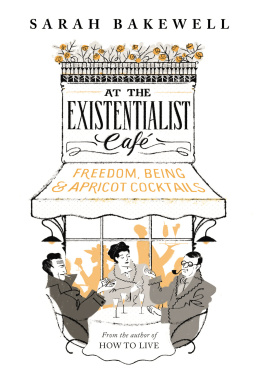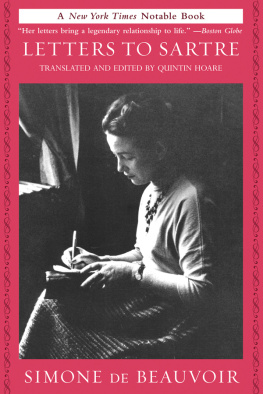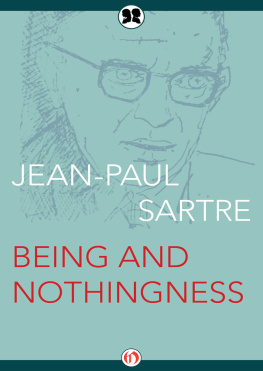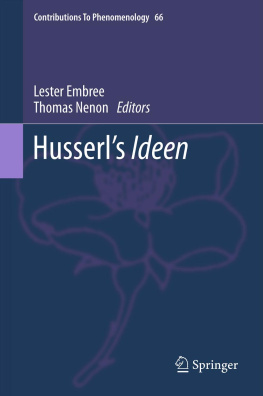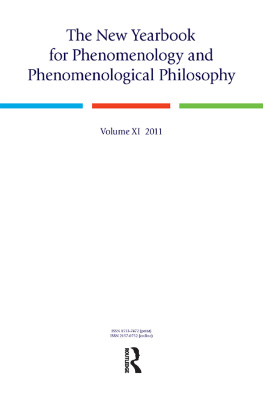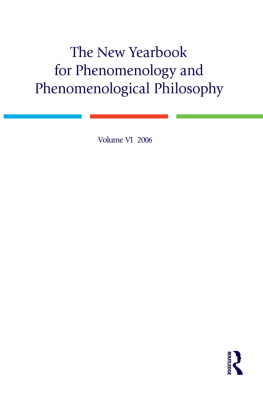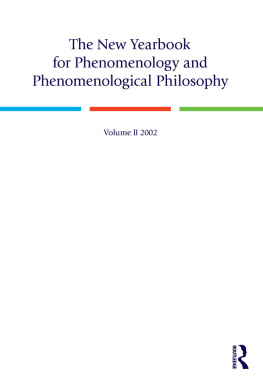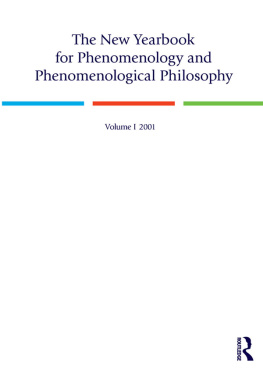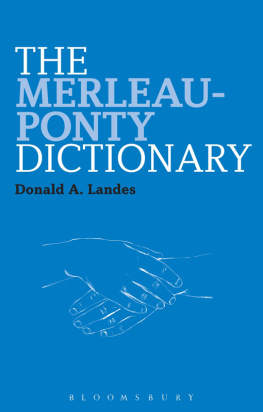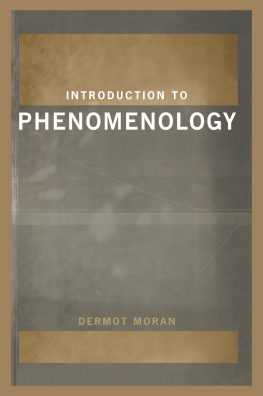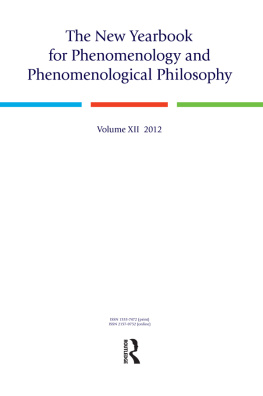Hans Rainer Sepp and L. Embree (eds.) Contributions To Phenomenology Handbook of Phenomenological Aesthetics 10.1007/978-90-481-2471-8_1 Springer Science+Business Media B.V. 2009
Immanuel Kant held that the judgment of taste bears on formal features that inhere in works of art as these inspire certain feelings in the subject. Taste is the faculty for judging an object or a kind of representation through a satisfaction or dissatisfaction without any interest. The object of such a satisfaction is called beautiful (Kant, opens as follows: In order to decide whether or not something is beautiful, we do not relate the representation by means of understanding to the object for cognition, but rather relate it by means of the imagination (perhaps combined with the understanding) to the subject and its feeling of pleasure or displeasure (ibid: 89). Despite this emphasis on the indispensability of the subjects experience in aesthetic judgment, Kants overall presumption is that the domain of art is to be understood in terms of the two poles of subject and object, experience and thing.
The predominance of this bipolar model is inseparable from the era of representationalism in modern Western philosophy. A representation (Vorstellung) is the response of a human subject to the appearance of discrete entities in space and time; the parade of these entities would be lost on a given human subject unless s/he had some capacity for representing them in memory or projecting them in imagination. This twofold activity of representation forms the very medium for the experience of art, where experience (Erfahrung) signifies the immanent relationship between such activity and its proper objects. But is such experience adequate for grasping the actuality of art?
M artin H eidegger thinks not. In Der Ursprung des Kunstwerkes (1935: 79). From the 18th century onward, recourse to experience has meant the subjectification of the artwork in the abyss of mental representations. Neglected are dimensions of the artwork that surpass the domain of subjectivity and representation, e.g., Being and the Open, Earth and World. Rather than being the contents of any possible subjective experience, these factors transcend such experience. From the very start, they take us somewhere else.
Nevertheless, the matter is not quickly settled. Phenomenological accounts of art, from E dmund H usserl to M ikel D ufrenne , insist on the pertinence of the experience-object schema to the appreciation, creation, and understanding of artworks. This suggests that that there is something right and relevant about thinking of art in terms of its being experienced by human subjects. Once the dogma of representationalism is removed from the schema, there is room for a more constructive and expansive notion of aesthetic experience and its contents. The major phenomenological aestheticians offer us a model for experiencing art in enriched and nuanced ways without being committed to the primacy of representation and its associated subjectivism.
Edmund Husserls analysis of Drers engraving Knight, Death, and the Devil, one of his rare allusions to art, is concerned with depiction and imagination. Depiction is certainly a matter of representation, yet not in the narrow modernist sense. Husserls focus is not upon the generation of representations in human subjects. Instead, he stresses the depictive properties of the engraving, and in particular how its lines, though perceived as physical entities on one level, are grasped as only quasi-existing on another: this depicturing picture-Object is present to us neither as existing nor as not existing, nor in any other positional modality; or rather, there is consciousness of it as existing, but as quasi-existing in the neutrality modification of being (Husserl, : 262). At stake here is imagination (Phantasie), conceived as the neutralizing of positing presentiations or presentifications such as memories and perceptions. (This is not to confuse neutrality modification with phantasy, since every phantasy is such a modification, but the modification itself has universal application; cf. ibid., 111, The Neutrality Modification and Phantasy.)
Husserl singles out a visual work of art composed of lines, with no color. Linearity is well suited to bring out issues of depiction, given that contour lines often stand in for the edges of objects. It does not matter that these objects do not come directly from the artists (or the spectators) personal experience. What matters is the effort to delineate all that is depicted in the engraving, thereby demonstrating that the realm of objects may include wholly imaginary entities such as the Devil or the Knight. Thus the spectator as well as the artist is invited to engage in an imaginative activity whose contents exceed the deliverances of ordinary perceptual experience. By invoking this invitation to imagine freely under the guidance of linear depictions, Husserl extends the notion of experience in art beyond the narrow limits of objective representation, which is tied to definite objects in a spatiotemporal field that pre-exists the representing subject. This is a crucial step toward formally acknowledging the pertinence of a much more expansive model of experience than was permitted in early modern thought under the regime of mental representation.
roman I ngarden provides a more comprehensive view of aesthetic experience than does Husserl. Where Husserl had been content to remark that literature allows unusual latitude in the employment of imagination (ibid.: 160), Ingarden carefully analyzes what a literary work and its experience consist in. Das literarische Kunstwerk (: 16). This identity relies upon ideal meaning units and cannot be reduced to any set of psychic experiences, no matter how wide-ranging and complete they may be. Such experiences do not belong to the literary work. Not even imagined objects can make up the fabric of the literary work, for these remain part of the psychic life of the author or reader, and are disparate from the meaning-formations and represented objects that make up a given works distinctive identity. Nothing that is psychic, whether as actual experience or as imagined object, can be a proper constituent of the literary work. It must be excluded as ruthlessly and surely as a thinkers actual thoughts from logic or mathematics. Thus scientific truth and artistic creation, once purged of their psychologistic reductions, converge despite their many manifest differences.
What distinguishes the literary work from a scientific theory is its peculiar structure: every work of literature presents itself to the reader as a series of strata that, though organically bound together in the readers experience, are distinguishable upon analysis. These strata are: linguistic sound formations, meaning units, schematized aspects, and represented objects. Each stratum conditions all the others in the conjoint action that makes up the work as a whole. Inspired by M ax S chelers model of the stratification of value in ethical life, Ingarden holds that each stratum bears its own particular form of value. There thus arises a manifold of aesthetic value qualities in which a polyphonic yet uniform value quality of the whole is constituted (ibid: 30). Such value qualities are no more reducible to experiences than are the ideal meanings that guarantee the coherence of represented objects. Together, such meanings and qualities ensure that the literary work is neither the physical object, e.g., the perceived page, nor the subjective experience of its author or reader. Nor is it the mere repository of representations at stake in the Cartesian subject; the final stratum of represented objects contains entities that are the creation of the work itself, not of any human subjectivity that purports to capture the perceived world in ideational or pictorial formats. On Ingardens conception, the only objects that matter are the purely intentional objects projected by units of meaning (ibid: 218).

